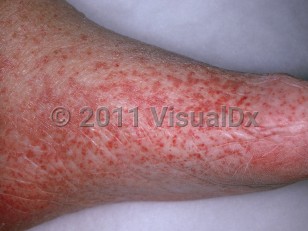Leukocytoclastic vasculitis in Child
Alerts and Notices
Important News & Links
Synopsis

LCV can occur in all ages and in both sexes. It is more commonly found in adults, but up to 10% of cases are in the pediatric population. The clinical hallmark of LCV is palpable purpura: purpuric papules and plaques erupt symmetrically on the shins 7-10 days after an inciting factor. Other parts of the lower extremities may be involved, including thighs and dorsal feet. Less frequently, the buttocks, upper extremities, and abdomen are involved. Initially, purpuric macules may be seen that progress to palpable purpura. In more advanced cases, bullae and ulcers may be seen. While the majority of cases are asymptomatic, LCV can be associated with pruritus, pain, or burning.
A variety of inciting factors have been identified, including medications (especially antibiotics, NSAIDs, and diuretics), pathogens (hepatitis viruses, HIV, Epstein-Barr virus, and streptococci), malignancy, inflammatory bowel disease (Crohn disease, ulcerative colitis), or connective tissue disease (systemic lupus erythematosus [SLE], Sjögren syndrome, and rheumatoid arthritis), and vaccinations (most recently reported, COVID-19 vaccine). Exercise-induced vasculitis, also known as golfer's vasculitis, is a very rare cause of LCV. It is triggered by strenuous exercise, such as running, prolonged walking, or golfing, particularly during warm weather. Up to 50% of cases, however, have no identifiable cause and are considered idiopathic.
Pathogenically, antigen-antibody complexes bind to the endothelium. The complement cascade is subsequently activated, effecting neutrophil chemotaxis. Vessel wall damage then ensues secondary to proteolytic enzymes and reactive oxygen species released by neutrophils.
The physician will need to differentiate skin-limited LCV from LCV with systemic involvement that may include fever, myalgias, malaise, lymphadenopathy, abdominal pain, melena, hematochezia, diarrhea, hematuria, lower extremity swelling, or paresthesias.
Codes
L95.8 – Other vasculitis limited to the skin
SNOMEDCT:
60555002 – Hypersensitivity angiitis
Look For
Subscription Required
Diagnostic Pearls
Subscription Required
Differential Diagnosis & Pitfalls

Subscription Required
Best Tests
Subscription Required
Management Pearls
Subscription Required
Therapy
Subscription Required
Drug Reaction Data
Subscription Required
References
Subscription Required
Last Updated:09/29/2024

